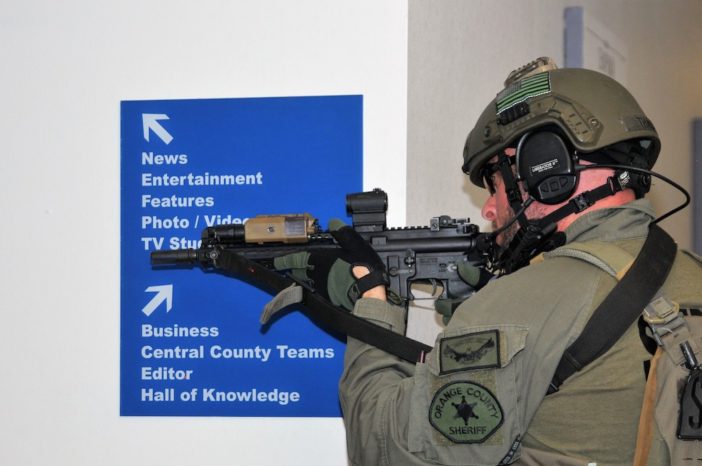Teams of gunmen roamed the top three floors of the office building as several terrified hostages sat motionless, explosives wired to their chairs.
Dozens of SWAT team members and tactical bomb technicians from multiple agencies responded to the “Category A” call in Santa Ana on Feb. 15, a designation used when victims are in danger of losing their lives.
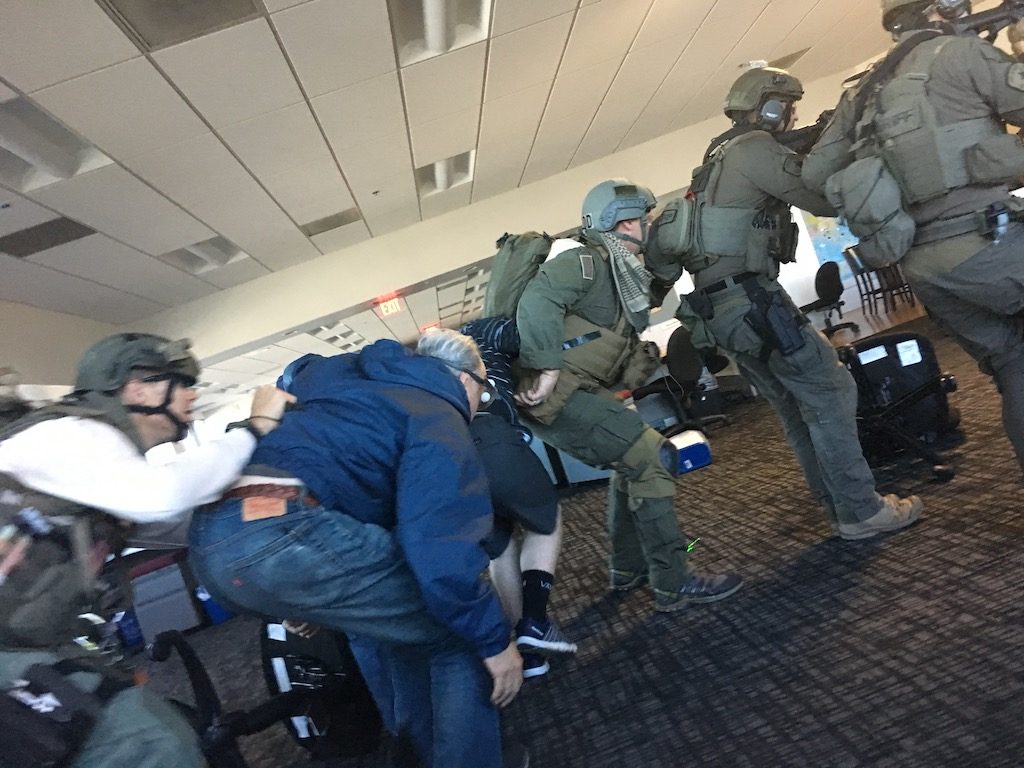
SWAT members escort freed “hostages” to safety on the third floor of the building. Photo by Greg Hardesty/Behind the Badge OC
After clearing the first two floors of the building, the Santa Ana PD had called for help.
Now it was up to the additional teams of highly trained and heavily geared-up deputies and officers to save the 12 hostages and kill or capture the bad guys, whose motive for storming the building was unclear.
Just after 11 a.m., gunfire began erupting after three teams of bomb technicians and SWAT officers and deputies stealthily gained access via stairwells to the building’s three top floors, each of which had been booby trapped with tripwires connected to explosives.
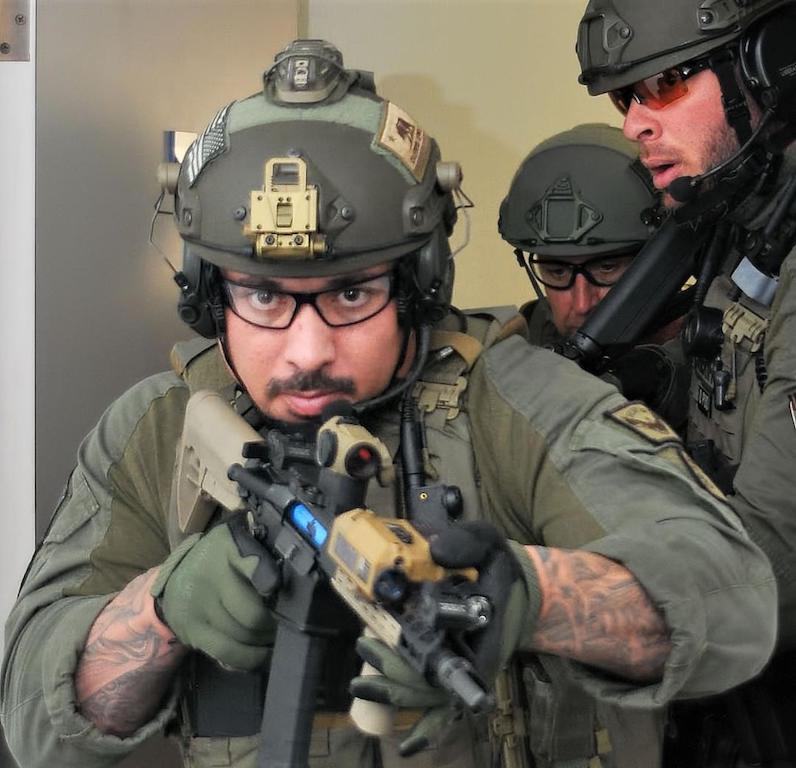
A member of a SWAT team displays a focused glare during an active-shooter training drill organized and hosted by the Orange County Sheriff’s Department. The scenario involved multiple active shooters holding hostages in an office building. Photo by Lou Ponsi, for Behind the Badge OC
Throw down your weapons!
We’ve got unclear threats behind us!
Don’t get up or you’re going to die!
The barked orders came regularly as bursts of gunfire rang throughout the building.
Eerily, this elaborate scenario hosted by the Orange County Sheriff’s Department played out less than 24 hours after the real-life massacre of 17 students and staff members at Marjory Stoneman Douglas High School in Parkland, Fla., on Valentine’s Day.
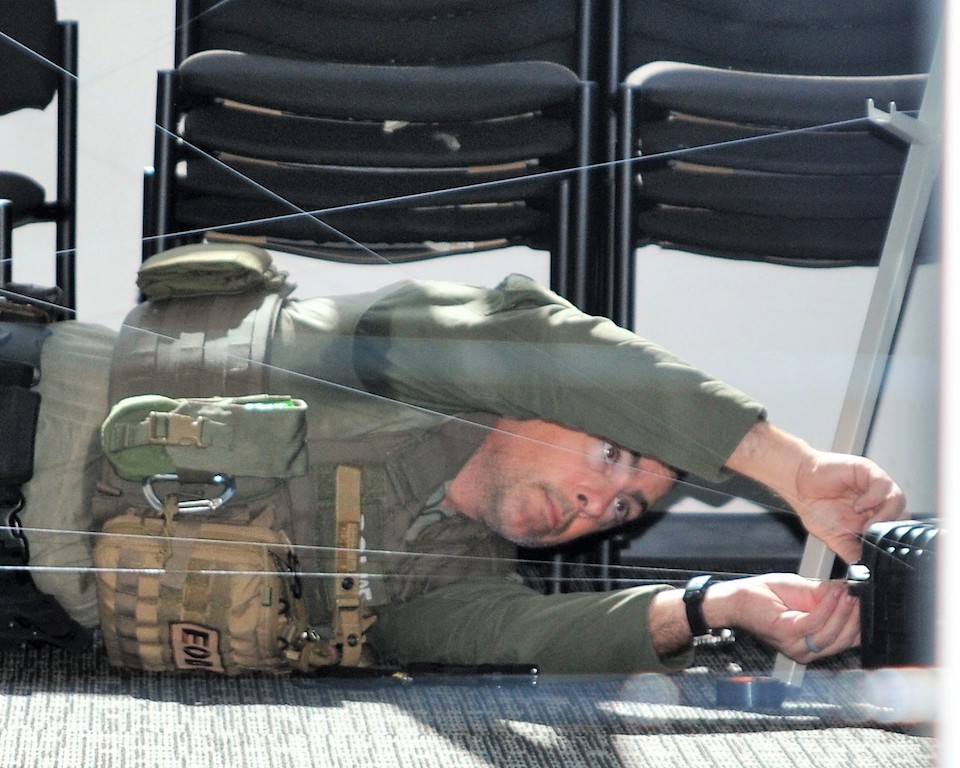
An OCSD bomb technician disarms an explosive device during a SWAT training drill involving multiple active shooters holding hostages in an Orange County office building. The SWAT team had to navigate around several booby traps, such as the tripwires seen in the photo. Multiple agencies participated in the operation, which was organized by the OCSD. Photo by Lou Ponsi, for Behind the Badge OC
That grim fact was not lost on one of the lead instructors during the Feb. 15 scenario, which came on the final day of two weeks of training for 14 tactical bomb technicians from California. Arizona and Colorado who were learning to work with SWAT teams.
“That’s why we’re here — we’re trying to get ahead of these threats,” said the instructor, who requested that his name not be used.
He told the large gathering at a briefing before the mid-morning hostage scenario that he had heard some students saying, “This is never going to happen.”
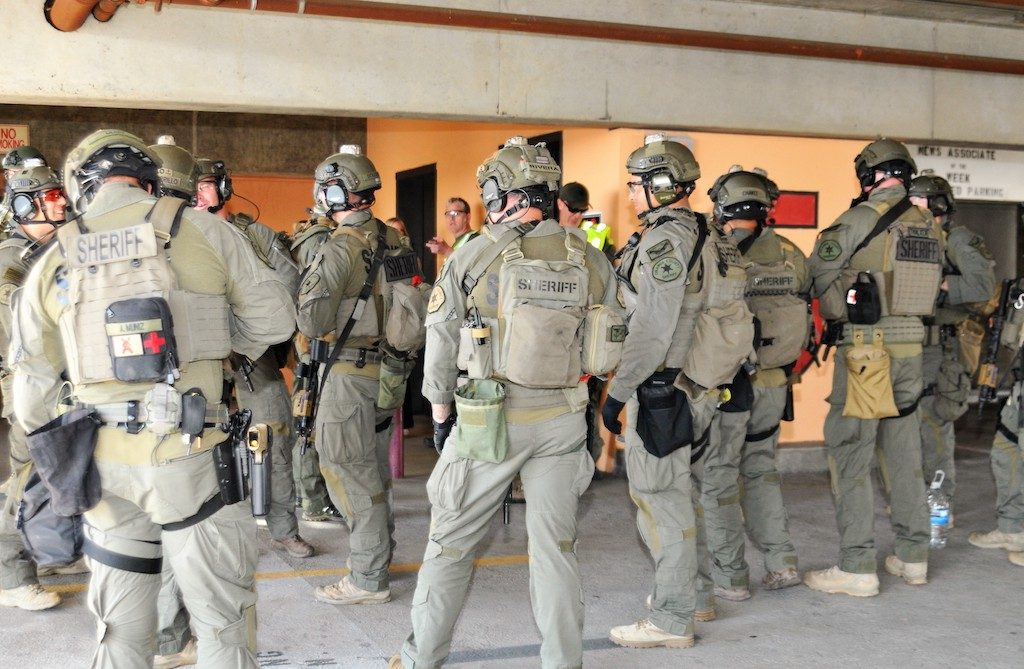
Participants in the SWAT scenario listen to final instructions before entering the office building. Photo by Lou Ponsi, for Behind the Badge OC
The intructor said he’s been involved in two SWAT incidents in his nine-year career.
“I just think we have to take the opposite attitude of that,” he said. “What are the odds of (something like this) happening? Remarkably slim. But we never train for the easiest possible scenario. We train for the worst-case scenario.”
JOINT TRAINING SESSION
The training scenario for the 14 tactical bomb technicians was folded into regular quarterly training for members of the Orange County Joint Hazard Assessment Team (JHAT), which consists of SWAT deputies and officers from the OCSD and the Huntington Beach, Irvine and Anaheim PDs.
The 14 students came from the Los Angeles, San Bernardino and Riverside County Sheriff’s Departments; the LAPD; the Jefferson County (Colorado) Sheriff’s Office, the Pima County (Arizona) Sheriff’s Department, the San Francisco PD and the San Diego PD.
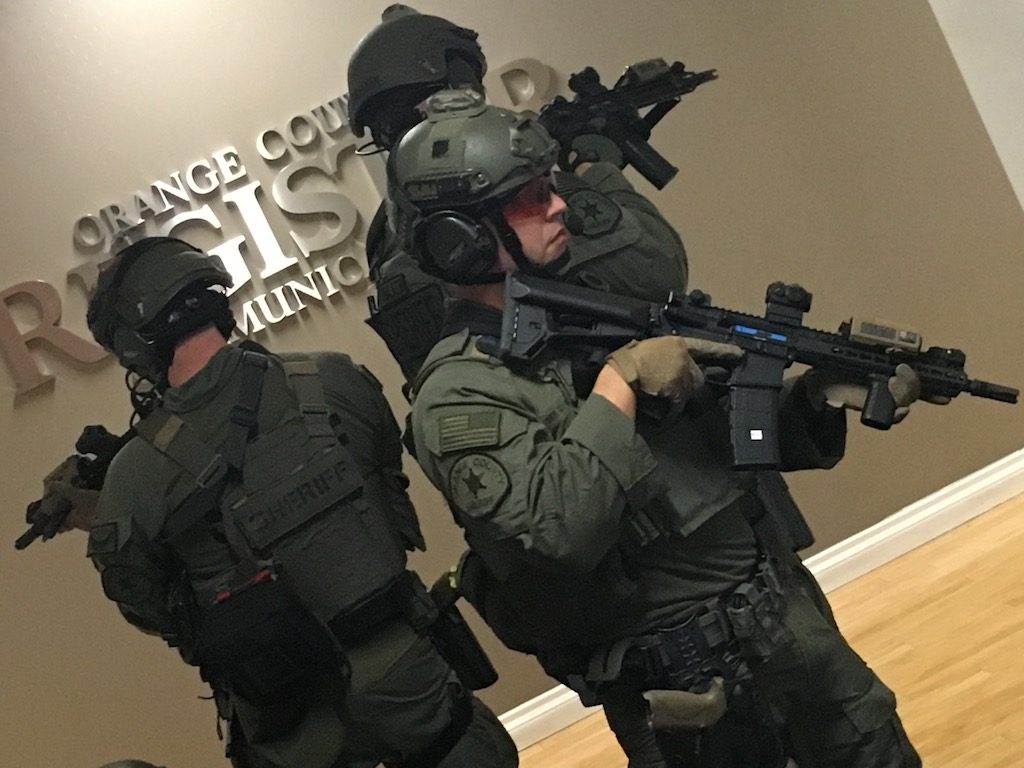
SWAT members from the Orange County Sheriff’s Department enter the building. Photo by Greg Hardesty/Behind the Badge OC
The purpose of the training was to teach the tactical bomb technicians, who work on bomb squads, how to operate and move through hazards in an active-shooter scenario involving SWAT teams.
The participants took the training very seriously. The goal was to get them to act during a scenario the same way they would on a real call, approaching everything with the same level of discipline.
SWAT officers from the Irvine PD worked with tactical bomb technicians on the fifth floor of the office building, while SWAT officers from the Huntington Beach and Anaheim PDs worked with them on the fourth floor.
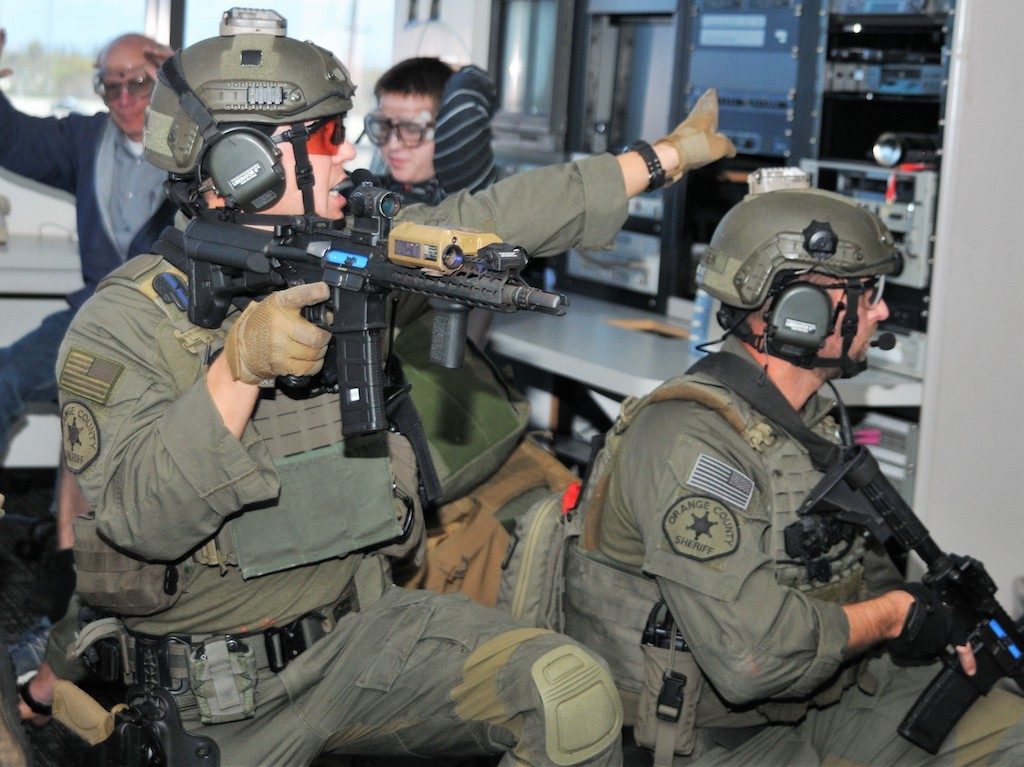
Members of the OCSD SWAT team participate in a training drill involving multiple active shooters holding hostages in an Orange County office building. Several agencies participated in the operation, which was organized by the OCSD. Photo by Lou Ponsi, for Behind the Badge OC
SWAT deputies with the OCSD worked the third floor, whose scenario was monitored by Investigators Greg Jensen and Chris Jensen, both members of the OCSD Bomb Squad.
Because there were desks, phones and other office equipment in the building, which is up for lease, it wasn’t the typical sterile and empty environment law enforcement teams use for active-shooter scenarios.
During the 45-minute scenario, bomb technicians ad-libbed with OCSD volunteers playing the role of hostages as they worked in a corner of the third floor, cutting the proper wires to defuse the explosives under the seats of the chairs.
We need you guys to relax and not move.
Stay low, stay low!
I hear a shot down range!
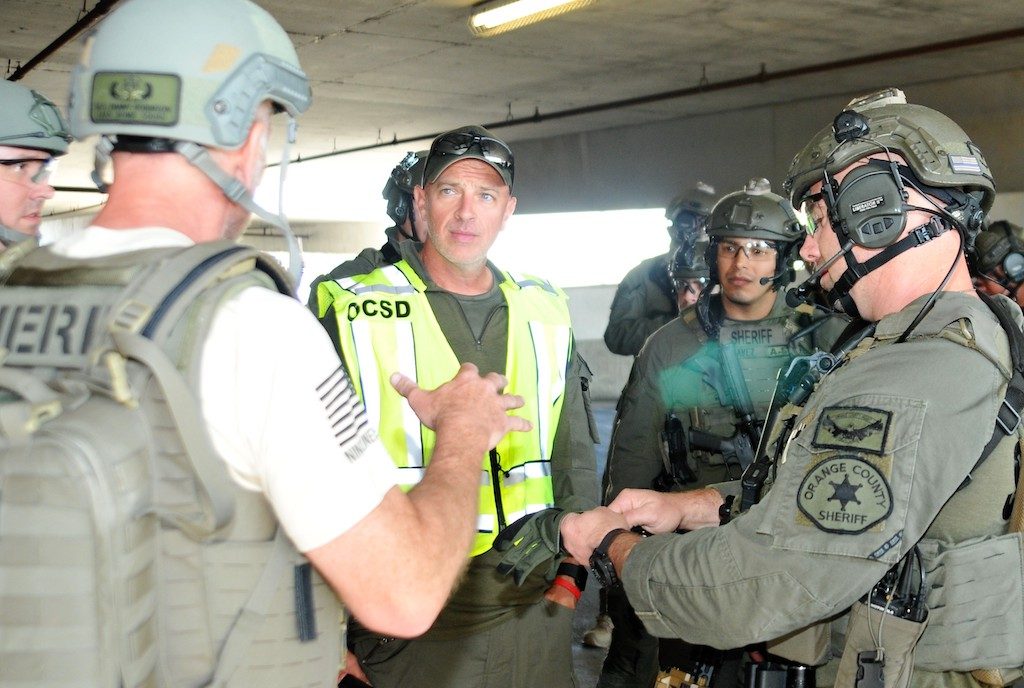
As part of a training drill involving active shooters holding hostages in an office building, members of the OCSD SWAT team discuss plans to enter the building, neutralize the threat and rescue the hostages. Photo by Lou Ponsi, for Behind the Badge OC
Other participants cleared trip wires that were set up throughout the floor. If someone had walked through a trip wire, it would have beeped, indicating an “explosion” had gone off.
But the teams of SWAT deputies and tactical bomb technicians successfully navigated the trip wires without setting them off.
One bad guy played dead after determining that the simunitions rounds that hit him would have been lethal if the bullets had been real. Participants were armed with modified weapons that shot 9mm paint rounds.
You’ll take point, and I’ll guide the hostages.
Is it clear or not?
We’ve got at least two shooters.
The teams working the third floor eventually took down another shooter who had been hiding behind a desk near a fourth hostage strapped to a chair placed on top of a conference room table surrounded with trip wires.
They successfully got that hostage to safety without setting off any “bombs.”

A member of the OCSD’s SWAT team is at the ready during a training drill organized and hosted by the Orange County Sheriff’s Department. Photo by Lou Ponsi, for Behind the Badge OC
Sgt. Randy Sterett, a member of the OCSD Bomb Squad for 22 years, said the scenario training went well.
So did other participants in the Feb. 15 exercise they hope never transpires in real life.
Their jobs, as always, remain clear:
Be prepared to stay ahead of all threats.
Said the lead instructor: “This is probably the most realistic set-up we’ve had among the 20 or so classes we’ve had so far.”
 Behind the Badge
Behind the Badge
